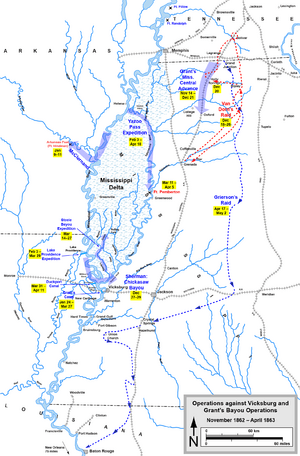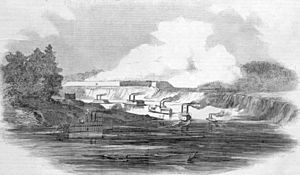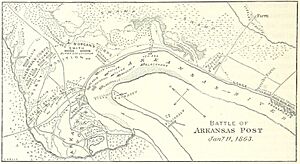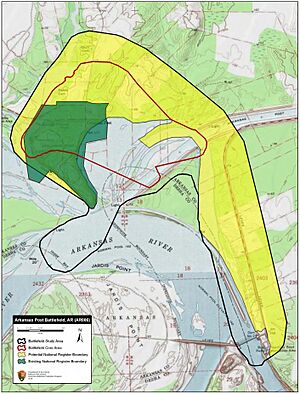Battle of Arkansas Post facts for kids
Quick facts for kids Battle of Arkansas PostBattle of Fort Hindman |
|||||||
|---|---|---|---|---|---|---|---|
| Part of the American Civil War | |||||||
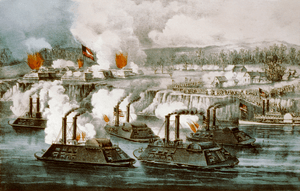 Bombardment and capture of Fort Hindman, Arkansas Post, Ark. Jany. 11th 1863, by Currier and Ives. |
|||||||
|
|||||||
| Belligerents | |||||||
| Commanders and leaders | |||||||
| David Porter John McClernand |
Thomas Churchill |
||||||
| Strength | |||||||
| 28,944 | 4,900 | ||||||
| Casualties and losses | |||||||
| 1,061: 134 dead, 898 wounded and 29 missing | 4,900: 28 dead, 81 wounded and 4,791 captured | ||||||
The Battle of Arkansas Post (also called the Battle of Fort Hindman) was a fight during the American Civil War. It happened from January 9 to 11, 1863. The battle took place near the mouth of the Arkansas River at Arkansas Post. It was part of the larger Vicksburg Campaign. Even though the Union Army won, this victory did not help them get closer to Vicksburg.
Contents
Why the Battle Happened
The Confederate Army built a large fort at Arkansas Post. It was made of earth and stood on a bluff 25 feet above the north side of the river. This fort was about 45 miles downriver from Pine Bluff. Its main job was to protect the Arkansas River. It also stopped the Union Army from reaching Little Rock.
The fort was named Fort Hindman, honoring General Thomas C. Hindman from Arkansas. It had a great view of the river for a mile in both directions. The fort was also a base for attacking Union ships on the Mississippi River. About 5,000 Confederate soldiers were stationed there. Most of them were Texas cavalry (horse soldiers) who now fought on foot, and Arkansas infantry. They were led by Brigadier General Thomas J. Churchill. By late 1862, many soldiers at Fort Hindman were sick. They also had trouble getting enough supplies.
Meanwhile, Union Major General John A. McClernand was a very ambitious politician. He got permission from President Abraham Lincoln to launch a large attack on Vicksburg. McClernand hoped this would bring him military fame and political power. However, his plan was different from that of Army of the Tennessee commander, Maj. Gen. Ulysses S. Grant.
McClernand ordered Grant's officer, Maj. Gen. William T. Sherman, to join his troops with McClernand's. Together, these two groups formed the Army of the Mississippi, with about 33,000 men. On January 4, McClernand decided to attack Arkansas Post instead of Vicksburg. He did not tell Grant or the main general, Maj. Gen. Henry W. Halleck, about this change.
The Battle Begins
January 9
On the evening of January 9, Union boats started landing troops. They landed near Notrebe's Plantation, about 3 miles below Arkansas Post. The Union soldiers began moving upriver toward Fort Hindman. Sherman's soldiers quickly took over the first Confederate trenches. The Confederate soldiers then fell back to the safety of the main fort. This fort was protected on the east by the Arkansas River. It also had trenches running west across the land.
By 11:00 AM the next morning, the rest of the Union army had landed. General Churchill was shocked by how many Union soldiers there were. He immediately asked his commander, Theophilus H. Holmes, for more troops. Holmes told Churchill to "hold out till help arrived or until all dead."
January 10
On January 10, the Union army moved closer to completely surround the Confederate fort. Two groups of soldiers from Peter J. Osterhaus's division were sent away from the main army. Colonel Daniel W. Lindsey's group landed on the riverbank across from the fort. Colonel John F. De Courcey's group stayed near the first landing spot as backup.
General George W. Morgan led Osterhaus's remaining soldiers along the river levee. Andrew J. Smith's division followed them. Sherman's soldiers followed with David Stuart's division along the river. Sherman also sent another division under Frederick Steele inland to try and attack from the side. However, they couldn't get through because the land was swampy and the roads were blocked. Morgan's soldiers pushed forward and took over the first Confederate trenches. These trenches were mostly defended by Texas cavalry who were fighting on foot.
As McClernand's soldiers moved toward the fort, Porter's gunboats attacked. The boats Baron DeKalb, Louisville, and Cincinnati fired at the fort from 400 yards away. A Union armored boat called the Rattler got too close. It got stuck and was hit hard by fire from the fort. After several hours, the Navy's attack had badly damaged the Confederate cannons.
Meanwhile, McClernand sent an army officer up a tree to see if Morgan and Sherman's troops were ready. The officer reported they were in place and ready to attack. But Sherman's troops were still moving through muddy swamps. By the time the Navy stopped firing, it was too dark for the foot soldiers to attack. Only some small fights happened.
January 11
On the morning of January 11, McClernand's soldiers were spread out in a curved line facing Fort Hindman and its trenches. From west to east were the divisions of Steele, Stuart, Smith, and Osterhaus, who was anchored on the Arkansas River. Churchill's defenses were held by Colonel James Deshler's group on the left and Colonel Robert Garland's group on the right.
McClernand's foot soldiers attacked around 1:00 PM. They didn't make much progress at first. At the same time, Porter's gunboats moved in to attack. Colonel Lindsey's soldiers across the river also helped. Within an hour, the east side of the fort was destroyed, and its cannons were silent.
Steele's attack on the west was led by Brig. Gens. Charles E. Hovey and John M. Thayer. Francis P. Blair, Jr.'s soldiers were held back as backup. To the east, Stuart supported with the groups of Colonels Giles Smith and Thomas Kilby Smith. They attacked the trenches held by Deshler's Arkansas and Texas soldiers. In the middle, A.J. Smith led his attack with Brig. Gen. Stephen G. Burbridge's group. Colonel William J. Landram's soldiers supported them. Burbridge's men got into a close-up gunfight. This caused more than a third of all Union injuries. Osterhaus moved toward the fort with Colonel Lionel A. Sheldon's single group.
At 4:30 PM, McClernand was planning a huge attack against the defenders. But then, white flags of surrender started to appear. The battle ended with some confusion. Porter's gunboats picked up soldiers from Lindsey's group. They ferried them across the river. These soldiers then climbed into the broken remains of Fort Hindman. Porter himself accepted the surrender of Colonel John Dunnington, who was in charge of the fort's cannons.
General Steele entered the trenches under a flag of truce to talk about surrender with Colonel Deshler. As they talked, Deshler noticed Steele's men kept moving closer. He demanded they stop or he would start fighting again. General Sherman arrived to find Churchill. However, Sherman watched as Churchill and Colonel Garland argued about surrendering. Garland said he had been ordered to surrender, but Churchill denied giving such an order. Colonel Deshler rode up and said he had not surrendered at all. He insisted on fighting again. Sherman ended the argument by pointing out that the Union forces had almost completely taken over the Confederate positions. Some Union soldiers had even started taking weapons from the Confederates.
One last scene happened when a Union officer rode into the fort. He demanded that the Navy leave so A.J. Smith's foot soldiers could take control. But the fort had already surrendered to Porter. Colonel Dunnington, who had been in the Navy, was a little happy. He got to surrender to another Naval officer instead of to the foot soldiers.
What Happened Next
"Glorious! Glorious! My star is ever in the ascendant. Now, on to Little Rock."
The loss at Arkansas Post cost the Confederacy a quarter of its soldiers in Arkansas. This was the largest surrender of Confederate troops west of the Mississippi River before the war ended in 1865.
Union forces had 1,061 casualties (killed, wounded, or missing). 134 Union soldiers died. The Confederates had 4,900 casualties, almost all of them captured. Even though Union losses were high, and the win did not help capture Vicksburg, it did remove another obstacle for Union ships on the Mississippi River.
General Grant was very angry about McClernand's detour from his main plan. Grant ordered McClernand back to the Mississippi River. He then broke up the Army of the Mississippi. Grant took personal command of the Vicksburg Campaign.
Some people disagree about why Grant removed McClernand. In his memoirs, General W.T. Sherman said that Grant did not send any message until after the battle. On January 13, after the army met at the mouth of the Arkansas River, McClernand showed Sherman a letter. In it, Grant said he did not approve of the plan. Sherman noted that Grant's letter was written before the battle's outcome was known. Sherman wrote, "When informed of this, and of the promptness with which it had been executed, he could not but approve."



